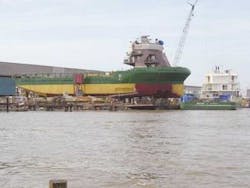One more way to improve cost efficiency offshore
Larry T. Rigdon
Rigdon Marine
The latest innovations in seismic and drilling technology can reduce the time and cost to drill a well offshore. This drive for continu-ous cost reduction provides long-term benefits to both the oil and gas companies and their service cont-ractors by making oil and gas the best, most cost effective energy choice.
In many circumstances, these cost reducing innovations in the oil industry are not revolutionary, but evolutionary. The current trend in efficiency improvement embodied in the latest design and operating performance of offshore platform supply vessels (PSVs) supporting offshore oil exploration, development, and production are a case in point. Ground up designs for PSVs, incorporating diesel-electric propulsion systems, offer significant improvements in vessel operating efficiency.
Diesel-electric propulsion systems
Some of the latest PSVs use diesel-electric propulsion systems, which allow streamlined hull designs, providing tremendous improvements in vessel speed, fuel efficiency, and station-keeping. When these design improvements are combined with better cargo tank layout and larger capacities, the customer can expect that total vessel charter costs (vessel charter costs plus fuel costs) to be significantly reduced.
These total vessel charter cost savings are further enhanced by improved station-keeping and systems redundancy, contributing improved overall safety and reducing negative environmental impacts.
Historically, the offshore supply vessel was built for maximum cargo capacity without a focus on hull efficiency (hull resistance or drag). The lack of focus on hull efficiency was the logical result of offshore oil exploration and production being close to shore and to the supporting port facilities, the relative low cost of diesel fuel and a lack of emphasis on air pollution, and the then higher cost of building more complex and efficient hull designs. The result of this logic is an existing PSV fleet that generally achieves a maximum speed of 10 knots at full cargo capacity of 1,800 to 4,000 tons of total cargo capacity using approximately 4,000 hp for propulsion.
Yesterday's logic for vessel design has been turned on its head. Today, offshore operations are often long distances offshore and far from dockside support facilities. Inexpensive computer-assisted vessel design and shipyard manufacturing technology make it cost-effective to build more complex and efficient hull designs. Vessel safety, fuel consumption, and the related volume of NOx emissions continue to grow in significance. Finally, the steady decrease in cost and increase in reliability of electronic power and control systems also dictate that diesel-electric vessels be given prime consideration for any new vessel design.
null
The logical result today is a vessel that can achieve an economical speed of 13 knots with less than the 4,000 hp for propulsion at the full cargo capacity, creating a dramatic improvement in overall operating efficiency and cost reduction.
Simply put, with a diesel-electric vessel, an electrical cable can be bent and twisted around structural elements of the vessel for the most efficient design. On the other hand, conventional direct drive PSVs must be designed with the structural elements accommodating the location of the engine room, the propulsion equipment, and the drive shafts. This generates a compromised PSV design with reduced vessel operating efficiencies.
Dynamic positioning
Modern electronic control and vessel management systems now incorporate inexpensive and reliable local area network (LAN) technology. Building redundancy into these systems is as simple as installing two redundant LANs that are in constant parallel operation with the backup system, or slave system, ready to replace the primary system immediately upon any failure.
These redundant systems also allow the diesel-electric PSV to obtain Dynamic Position class 2 (DP-2) certifications at a relatively low cost. DP-2 means that every control system and means of propulsion on the vessel has a redundant counterpart that will allow the vessel to maintain position, even when there is a failure in the control or propulsion system of the PSV.
The DP-2 redundancy significantly enhances the safety of vessel operations. A "classed" DP-2 system will reduce fatigue for the navigation officers and decrease their stress during long periods of maintaining position in close proximity to offshore facilities. Reduced fatigue and stress will enhance alertness and improve the judgment of the navigation officers resulting in safer operations.
In addition, DP-2 systems, combined with improved hull designs, increase the safe operating parameters for the modern PSV. A "classed" DP-2 vessel can maintain a constant, relative position from an offshore structure without placing mooring lines on the offshore facility for each loading and discharge operation. This eliminates handling mooring lines to the offshore facility and thus eliminates one of the highest risk activities performed by the crew members of conventional PSV's not equipped with DP-2 technology.
A modern diesel-electric PSV will also provide improved fuel efficiency and reduced air pollution as a result of the automated power management system. The power management system is computerized and constantly monitors the total electrical power requirement of the vessel. The automated power management system then matches the PSV's current power requirements to the best, most efficient combination of the three or four diesel generators installed in the modern diesel-electric PSV to minimize fuel consumption and related air pollution elements.
The development of the modern diesel-electric design demonstrates that existing technology can be used to cost effectively improve the overall efficiency of a PSV. The results are improvements in safety, cost efficiency, and reduced environmental impacts that benefit the entire offshore oil industry.

